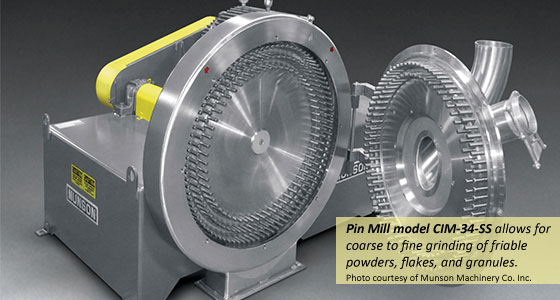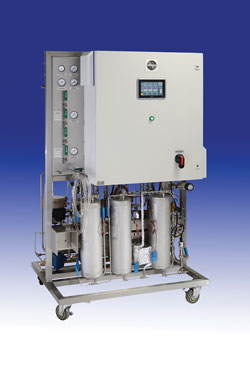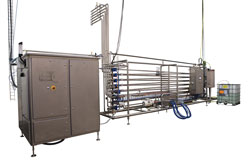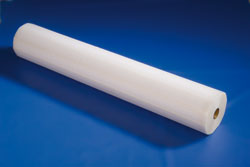2013 Processing and Engineering Highlights
Processing Preview

The 2013 Annual Meeting Scientific Program of symposia in areas of interest to me and readers of this column is daunting in size and scope and probably impossible to cover as well as it deserves. Here, however, are brief descriptions digested from the program abstracts of some of the more intriguing sessions scheduled to take place this summer in Chicago.
Novel Processing
On Monday, July 15, from 10:30 a.m. to noon, the focus will be on identifying, describing, and discussing the latest advances in novel nonthermal and chemical-free (green) processing technologies for extraction, separation, and transformation of food components in session 117 titled “Applications of Novel Nonthermal Processing Technologies for the Extraction, Modification and Separation of Food Components.”
A few emerging nonthermal technologies have been recently investigated and demonstrated to deliver alternatives for conventional extraction, modification, and separation of food components. These include ultrasound low frequency (<100 kHz) extraction and structure modification and high frequency (>100 kHz) particle separation, electrodialytic separations combined with ultrafiltration, pulsed electric field extraction and product pretreatment, and shock waves for extraction and product modification.
In session 016 “Applications of Nanotechnology Advances in Food Engineering and Processing,” from 10:30 a.m. to noon, Sunday, July 14, the focus will be on nanotechnology-inspired innovations in food processing and controlled delivery systems.
Electro-heating encompasses a family of technologies that can be used for rapid, efficient heating of a variety of food products. Electroheating spans a wide range of frequencies, from 0 Hz (direct current or ohmic heating) to several Mega-Hertz (microwave heating). The product’s reaction to an applied electric field is dictated by its electric and dielectric properties. The topic in session 181 on Monday, July 15, from 1:30 p.m. to 3 p.m. will be “Electroheating in Food Engineering: A Spectrum of Possibilities.”
To introduce the latest biochemical advance of fermentation and development of food enzymology, session 237 will be led by four experts who will give presentations emphasizing food enzymes in terms of the gene expression and fermentation techniques for production of glucosidase, fructotransferase, galactosidase, and aminopeptidase, and their molecular characterization, as well as their potential commercial applications. This session will take place from 8:30 a.m. to 10 a.m. Tuesday, July 16. It is titled “Challenges and Opportunities for Food Enzymes: Fermentation, Gene Expression, Characterization, and Application.”
Currently there is no commercial food production line using pulsed electric field (PEF) technology. There must be some obstacles that block this technology moving from labscale to full production. The speakers in session 101 will discuss the obstacles, challenges, and possible solutions regarding PEF equipment cost, production cost, research scale-up and process validation, and other concerns. The symposium, which will take place from 8:30 a.m. to 10 a.m. Monday, July 15, is titled “Commercialization of Pulsed Electric Field Technology in Food Industry: Obstacles from Lab to Full Production.”
Berries are unique fruit crops with distinguished flavor, color, and taste, and are high in many different bioactive compounds. With the benefit of nonthermal processing technologies, ultra-high temperature pasteurization, aseptic packaging techniques, and other innovative processing technologies, berry fruit can be processed with ensured food safety and stored for extended periods with very little deterioration in the nutritional and sensory qualities, a topic that will be discussed in session 102 titled “Latest Development and Innovation in Berry Juice and Puree Processing.” Specialty berry crops as well as challenges associated with retaining bioactive compounds during processing and storage will also be considered in the session from 8:30 a.m. to 10 a.m. Monday, July 15.
It is the goal of session 242 “Advances in Confectionery Technology,” which will take place from 8:30 a.m. to 10 a.m. on Tuesday, July 16, to demonstrate the latest technological developments in this area. The focus will be placed on technological developments (process-structure relationships, resource efficiency), ingredients (preferments), and statements on storage stability (color).
U.S. Food and Drug Administration (FDA) and Health Canada approvals of ultraviolet (UV) light as an alternative to thermal treatments of juice products and recent engineering developments have led to the growing interest in research and commercialization of UV technology. Despite the challenge of low UV penetration, a few techniques have been developed for processing fluids to control microbial safety. UV photopurification technology employs a turbulent flow when fluid is pumped through a series of “turbulators.” These topics will be addressed in session 281 “Ultraviolet Technology Achieves Better Safety and Quality of Foods through Sustainable Production,” from 1:15 p.m. to 2:45 p.m. Tuesday, July 16.
Sustainability
“Research Needs for a Sustainable Food System” will be the topic from 8:30 a.m. to 10 a.m. Monday, July 15, in session 111. The overall goal of this symposium is to provide a forum for discussion of life cycle assessment and applications to the food system.
“Innovative Biorefinery Concepts to Boost the Bioeconomy” will be considered from 10 a.m. to noon Monday, July 15, in session 115. Biorefinery concepts include all of the main principles of thermal, mechanical, chemical, and biotechnological engineering. A huge number of food companies are already using some simple biogas refineries, for example. However, this is just the beginning of many engineering-based solutions. Different conversion and separation techniques used for food side streams or food waste will be presented.
Session 183 “Reduce, Reuse, Recycle: A Sustainable Packaging Approach” will give an update on new trends and advances in sustainable food packaging solutions. The session will take place from 1:30 p.m. to 3 p.m. Monday, July 15.
--- PAGE BREAK ---
Function and Properties
An enormous range of food processes can be viewed as involving transport of energy, moisture, and other components through deformable or rigid porous media at scales varying from macroscale to nanoscale, combined with chemical reactions. The topic will be addressed in session 045 “Food as Porous Media: Novel Approaches to Improved Understanding and Optimization of Processes” from 1:30 p.m. to 3 p.m. on Sunday, July 14.
Three different case studies for structure function relationships in dairy, meat, or cereal products will be presented in session 047 “Case Studies for Structure: Function Relationships in Dairy, Meat, and Cereal Products” from 1:30 p.m. to 3 p.m. Sunday, July 14. The session should be of substantial interest to food manufacturers that are struggling with or are interested in better controlling structure of complex food matrices, of which dairy, meat, and cereal products are but a few examples.
“New Tools to Understand Impact of Processing on Milk Powders: Quality and Functionality” will be explored in session 238 from 8:30 a.m. to 10 a.m. Tuesday July 16. Various processing and drying conditions have great impact on the dairy ingredient particle characteristics such as size, shape, porosity, and density, which in turn can impact the final quality of milk powder properties.
Enzymes induce remarkable changes in both the microstructure and the functional properties of carbohydrates—in the bread industry, for example, as lipases for dough strengthening, hemicellulases (and especially xylanases) for dough conditioning, amylases for fresh keeping, oxidases for gluten strengthening, and proteases for gluten weakening. “New” enzymes like asparaginase for removal of acrylamide in biscuits and crackers have been developed and launched to the market. Also, there has been extensive research in the past few years on enzymatic conversion of insoluble fiber into functional soluble fiber to act as prebiotics. Topics such as these will be the focus in session 266 “Rethinking Carbohydrates with Enzymatic Modifications to Improve Textural and Nutritional Functionalities of Products” from 10:30 a.m. to noon Tuesday, July 16.
A panel discussion from 10:30 a.m. to noon Tuesday, July 16, session 267 will bring together government, IFT leadership, industry stakeholders who regularly recruit food science graduates, university faculty, and students to discuss math and quantitative skills education. It is titled “Math and Quantitative Skills of Food Science Majors: Stakeholders’ Expectations and Current Food Science Curriculum Framework.”
Food Safety and Defense
Emerging combination processing techniques have been widely investigated by a number of researchers to overcome the drawback of each technique and maximize the synergistic impact on food quality and safety. This approach will be considered in session 268 “Hybrid Combination Techniques in Food Processing for Improving Food Quality and Safety,” which will take place from 10:30 a.m. to noon Tuesday, July 16.
“Case Studies in Nonthermal Technologies for Spore Decontamination, Bio-films, and Preventative Controls for Food Safety” is the title for session 018 from 10:30 a.m. to noon Sunday, July 14. Nonthermal technologies are becoming leading sources of innovation for ensuring food safety, while retaining food quality and acceptance. This symposium features recent scientific breakthroughs in the study of bacterial spore germination mechanisms by nonthermal technologies such as High Pressure Processing (HPP) using a progression of select mutant strains targeted for their differences in receptors and spore germination characteristics and provides anunderstanding for developing strategies for overcoming bacterial spore resistance.
Cantaloupes, watermelons, and honeydew melons have all been associated with foodborne disease outbreaks. Novel thermal and nonthermal surface treatments of fresh cantaloupes, watermelons, and honeydews for inactivating human pathogens will be presented with field validation data from commercial settings in session 236 “Innovative Processing Methods to Improve Cantaloupe Microbial Safety and Quality” from 8:30 a.m. to 10 a.m. Tuesday, July 16.
“Optimizing Processing & Distribution Temperatures for Processed Foods” will examine temperature control for processed foods in session 004 from 7:15 a.m. to 8:15 a.m. Sunday, July 14.
Formulating and manufacturing gluten-free foods comes with its own set of hurdles, from poor product quality to gluten contamination issues. Managing these challenges starts in the lab and continues on to the end throughout manufacturing and foodservice food preparation. These challenges will be addressed in session 269 “Keeping Gluten-free Free of Gluten Using Techniques & Creating Programs.” This panel session will take place from 10:30 a.m. to noon Tuesday, July 16.
Session 019 “Strategies and Technology to Prevent/Detect Economic Adulteration of Food” from 10:30 a.m. to noon Sunday, July 14, will consider the issue of economic adulteration from an industry perspective.
Session 022 “Progress in Implementing the 2011 Food Safety Modernization Act (FSMA) for Food Imports into the U.S.A. Impact on Global Supply Chains” will take place from 10:30 a.m. to noon Sunday, July 14. It is a follow-up to the 2012 IFT session on FSMA for imports. The U.S. Food and Drug Administration (FDA) has been developing specific rules and guidance documents for the implementation of FSMA. An update on these new rules and related guidance documents for the food industry will be provided.
“Concerns and Criteria for the Proper Use of Pathogen Surrogates in the Completion of Food Safety Research and Process Intervention Validation” will be addressed in panel session 046 from 1:30 p.m. to 3 p.m. Sunday, July 14. This symposium will discuss inherent limitations to the use of non-pathogenic organisms as surrogates for microbial pathogens to complete food safety research from the perspective of farmto-fork food safety management, offering recommendations on best practices for selection of pathogen surrogates.
Exhibitor Information
Brief descriptions of some of the processing-related exhibits at the IFT Food Expo follow.
 Veros™ UHT/HTST processing systems from MicroThermics, which will be on display at the Food Expo, offer the benefits of the company’s lab-scale processors at a substantially reduced cost. Their ease of use, commercially accurate process, and small batch sizes allow clients to quickly, efficiently, and cost-effectively get products to market. The equipment is available with a range of hold tubes, in-line homogenization, and ultra clean filling and is cable of processing products including juices and teas, milk and soy milk, and smoothies and ice cream mixes. MicroThermics Inc., www.microthermics.com, Booth 919
Veros™ UHT/HTST processing systems from MicroThermics, which will be on display at the Food Expo, offer the benefits of the company’s lab-scale processors at a substantially reduced cost. Their ease of use, commercially accurate process, and small batch sizes allow clients to quickly, efficiently, and cost-effectively get products to market. The equipment is available with a range of hold tubes, in-line homogenization, and ultra clean filling and is cable of processing products including juices and teas, milk and soy milk, and smoothies and ice cream mixes. MicroThermics Inc., www.microthermics.com, Booth 919
Miniature-scale research and development systems for the food and beverage industry are designed to allow product developers to replicate manufacturing processes on a small scale, thus allowing for quick and easy testing of product formulations and delivering cost-saving and space-saving benefits. Armfield’s latest addition to its range of UHT/HTST systems is the FT74XTS UHT/HTST system. An upgrade of Armfield’s FT74X, with features that facilitate control and data collection, it incorporates a full-color touch screen control interface that allows users to analyze temperature data while they work. Armfield Ltd., www.explorearmfield.com, Booth 500
--- PAGE BREAK ---
Pin Mill model CIM-34-SS (photo above) allows for coarse to fine grinding of friable powders, flakes, and granules. The 34-inch, sanitary stainless steel pin mill features an inner disc that rotates at high speed, creating centrifugal force that accelerates bulk material entering the central inlet of the opposing stationary disc. The vertical orientation of the mill housing results in a smaller footprint than horizontally oriented units and permits the outer disc to hinge open, providing quick access to all productcontact surfaces for cleaning and inspection. Munson Machinery Co. Inc., www.munsonmachinery.com, Booth 2779
One of the world’s largest suppliers of process technology and equipment for the food industry, GEA Group has locations in more than 50 countries. The company’s numerous divisions supply equipment and expertise in areas including freeze drying, spray drying, particulate processing, powder packingand transport, membrane filtration, high pressure pumps, homogenizers, rotary valves, separators, and much more. GEA Process Engineering designs and sells production plants and systems for the dairy, brewery, food, chemical, and pharmaceutical industries, offering dependable and advanced processing solutions. GEA Group, www.gea.com, Booth 904
 PurePulse mild preservation technology (photo above) extends the shelf life of juices and other beverages to at least 21 days without the loss of vitamins, aroma,color, or flavor. A continuous preservation process, PurePulse technology will be launched in the United States at the Food Expo. The process may be considered an extension of “classical” pulsed electric field technology, achieving pathogen reduction with minimal thermal impact. Goodnature Products, www.goodnature.com, Booth 571
PurePulse mild preservation technology (photo above) extends the shelf life of juices and other beverages to at least 21 days without the loss of vitamins, aroma,color, or flavor. A continuous preservation process, PurePulse technology will be launched in the United States at the Food Expo. The process may be considered an extension of “classical” pulsed electric field technology, achieving pathogen reduction with minimal thermal impact. Goodnature Products, www.goodnature.com, Booth 571
Steam/vacuum pasteurization system (schematic above) from Specialty Food Ingredients employs saturated steam in a partial vacuum to eliminate microbiological contamination of nuts and seeds without the use of chemicals while maintaining the products’ nutritional, organic, and sensory attributes. The company has received formal validation for use of the system for walnuts, macadamia nuts, pumpkin seeds, cashews, pine nuts, and hazelnuts. Specialty Food Ingredients, www.specialtyingredients.com, Booth 4217
 SPIRA-CEL® spiral membrane elements (photo below) are available in standard and custom sizes in the range of micro, ultra, and nano-filtration. Effective performers in dairy and food applications, SPIRA-CEL elements offer excellent retention, high fluxes, and a long lifetime. A longtime manufacturer of membrane filtration products, Microdyn will be showcasing a variety of membrane products. Microdyn Technologies, www.microdynnadir.com, Booth 1460
SPIRA-CEL® spiral membrane elements (photo below) are available in standard and custom sizes in the range of micro, ultra, and nano-filtration. Effective performers in dairy and food applications, SPIRA-CEL elements offer excellent retention, high fluxes, and a long lifetime. A longtime manufacturer of membrane filtration products, Microdyn will be showcasing a variety of membrane products. Microdyn Technologies, www.microdynnadir.com, Booth 1460
 J. Peter Clark, Ph.D., CFS,
J. Peter Clark, Ph.D., CFS,
Contributing Editor,
Consultant to the Process
Industries, Oak Park, Ill.
[email protected]
